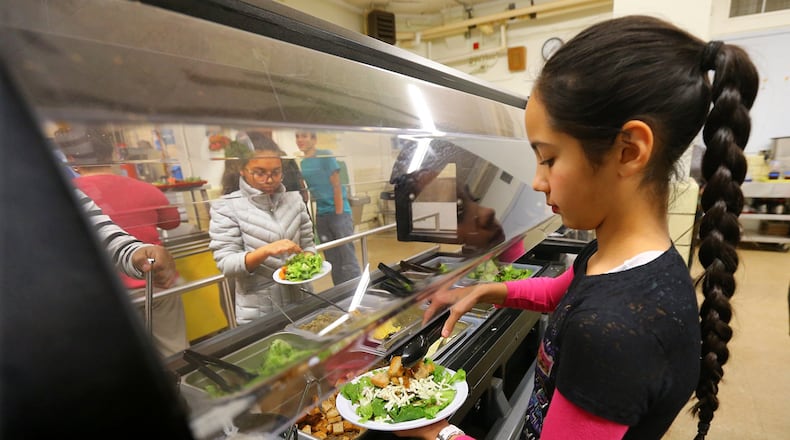Standing before a handful of public school nutritionists in a wide-brimmed hat and cowboy boots, Georgia Agriculture Commissioner Tyler Harper lauded their efforts to bring more fresh, locally grown food to school cafeterias.
“In America, we have some chronic epidemic situations and a lot of that is tied back to your nutrition,” Harper said. “The work that you’re doing in serving local Georgia-grown product is helping address that issue, and those are some things that we’re willing to help continue to take head on.”
Harper was speaking at a luncheon last month to celebrate the state’s successful efforts to get more locally grown fruits, vegetables, meat and dairy on school children’s plates.
But now, schools and food banks across the country will have less money than they expected to buy locally produced food.
That’s because the U.S. Department of Agriculture canceled or paused more than $1 billion in funding that had been approved in the waning days of the Biden administration to continue existing programs.
Georgia officials confirmed about $27 million in previously awarded funds had been canceled so far amid rumors of more cuts.
The cuts come at a time of rising economic insecurity as new tariffs roil markets and inflation remains stubbornly high. Some school nutritionists and food banks warned that rescinding funding for food could harm vulnerable children and families.
Credit: Meris Lutz
Credit: Meris Lutz
Tina Farmer, the executive director of school nutrition for Cherokee County, said some of the federal funds that were cut helped her school buy more expensive, grass-fed beef from a Georgia farm to use in nachos and tacos — a big hit with students. The loss of that program, which started in Georgia in 2023, means the district will have to cut back on how often it serves premium ingredients, she said, adding that about 36% of students in the district qualify for free or reduced meals.
“There are students that the meals they receive at breakfast and lunch [at school] are the only healthy meals that they are receiving,” said Farmer. “We really want to make sure that we are providing the best possible meal that we can for them.”
According to data from the Georgia Department of Education, Cherokee County received more than $300,000 for locally grown food from one of the targeted programs. In total, more than 80 districts across Georgia received $4.5 million to buy food from hundreds of local producers.
Kyle Waide, CEO and president of the Atlanta Community Food Bank, said he was aware of cuts potentially totaling 10% of the organization’s food volume at a time of rising demand for food assistance. That’s how much he estimates would be affected by a cut of $1.7 billion in federal food aid funding, though the exact dollar amount of the federal cuts is unclear.
The Atlanta Community Food Bank serves 60% more people than it did three years ago across the same 29 North Georgia counties, Waide said. That number could rise even higher if the coming months bring an economic downturn or cuts to programs for the poor like Medicaid or the Supplemental Nutrition Assistance Program.
“A really large number of families are facing economic pressure,” Waide said. “Our view is that this is not a time for austerity.”
A USDA spokesperson said in an email that the agency terminated a “Biden-era slush fund” while remaining focused on its “core mission of strengthening food security, supporting agricultural markets, and ensuring access to nutritious foods.” The spokesperson also faulted the Biden administration for extending programs that were created in response to the coronavirus pandemic beyond the crisis.
The spokesperson did not answer questions about how much money was cut in total from the federal programs or from Georgia specifically, and instead pointed to a new $261 million allocation for produce made available to all states through a different program. However, that amount falls far short of what was reportedly cut.
“The Department will continue to use its procurement authority to support producers and consumers where appropriate, and with 16 nutrition programs under its purview, ensure families continue to have access to affordable and abundant food,” they said.
Credit: Meris Lutz
Credit: Meris Lutz
Even as the Trump White House seeks to slash federal spending, officials are also reportedly weighing new aid for farmers impacted by the president’s escalating trade war.
Commissioner Harper, a former Republican state lawmaker, praised the local food programs as a success but stopped short of criticizing the federal cuts. He said the problems facing farmers should be viewed in the larger economic context and that his agency would continue to engage in “conversations” with the Trump administration about these issues.
Parrish Akins, who runs ACE Beef with his family in Nashville, Georgia, said the Berrien County School District accounts for 25% to 30% of his sales.
According to data from the Georgia Department of Education, Berrien has received about $26,000 in local food funding. The district did not immediately respond to a request for comment about how the cuts might impact its food procurement.
Akins said he was concerned about the impact of the cuts on the local economy.
“I’m on board with eliminating waste,” said Akins, a Republican. But, he added, “I do not think the actual program itself is wasteful.”
“I would like to see that program expanded,” Akins said. “[It’s] a benefit to the consumer, being the school kids, also a benefit to me as a local producer.”
The affected programs include two approved in response to the coronavirus pandemic — the Local Food to Schools program and the Local Food Purchase Assistance program.
Letters sent to the state departments of education and agriculture last month informed them that local food funding contracts were being canceled because they no longer “effectuate” agency priorities. Some $30 million in previously approved awards will continue to be spent down until they finish, officials said.
News reports have also identified cuts to a third program, the Emergency Food Assistance Program, which has been around since the 1980s — but the Georgia Department of Human Services, which oversees it, could not confirm any changes.
“We are aware of these news reports, but have not received confirmation from our federal partners of such cuts and therefore cannot speculate,” Georgia DHS spokeswoman Ellen Brown said in an email.
Georgia officials said some state funding is available to promote locally grown food and nutrition in schools, and the federal government continues to provide subsidies for income-qualified households through its free and reduced meal program.
The Georgia Department of Agriculture budgets about $2.8 million a year for its “Georgia Grown” marketing program. The Georgia Department of Education in its fiscal year 2025 budget allocated about $42 million to school nutrition and meal subsidies, but most of that is for lunchroom worker salaries, not food purchases, according to a report from the state House Budget and Research Office.
Nicole Trunk, the director of nutrition for Barrow County schools, said she’s noticed that students are more likely to try new food when it’s advertised as being locally grown. She said losing any funding for food purchases would hurt.
“I wish it would continue, because it’s been a tremendous help with our budget and all, and it helps the farmers,” Trunk said.
She said about 61% of her students qualify for free or reduced meals. The district received more than $100,000 in local food funds, according to the state Department of Education.
A note of disclosure
This coverage is supported by a partnership with Green South Foundation and Journalism Funding Partners.
About the Author
Keep Reading
The Latest
Featured





